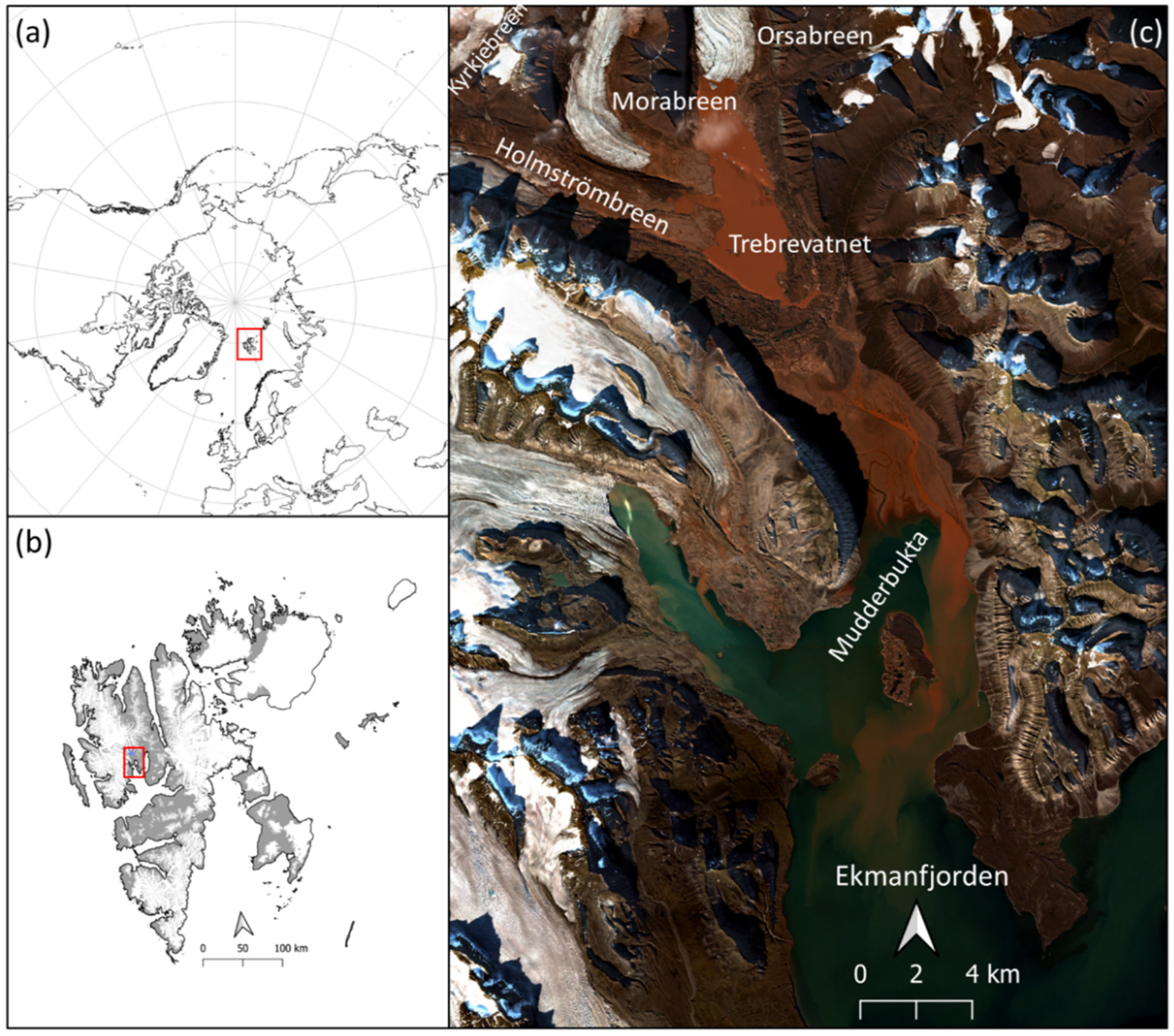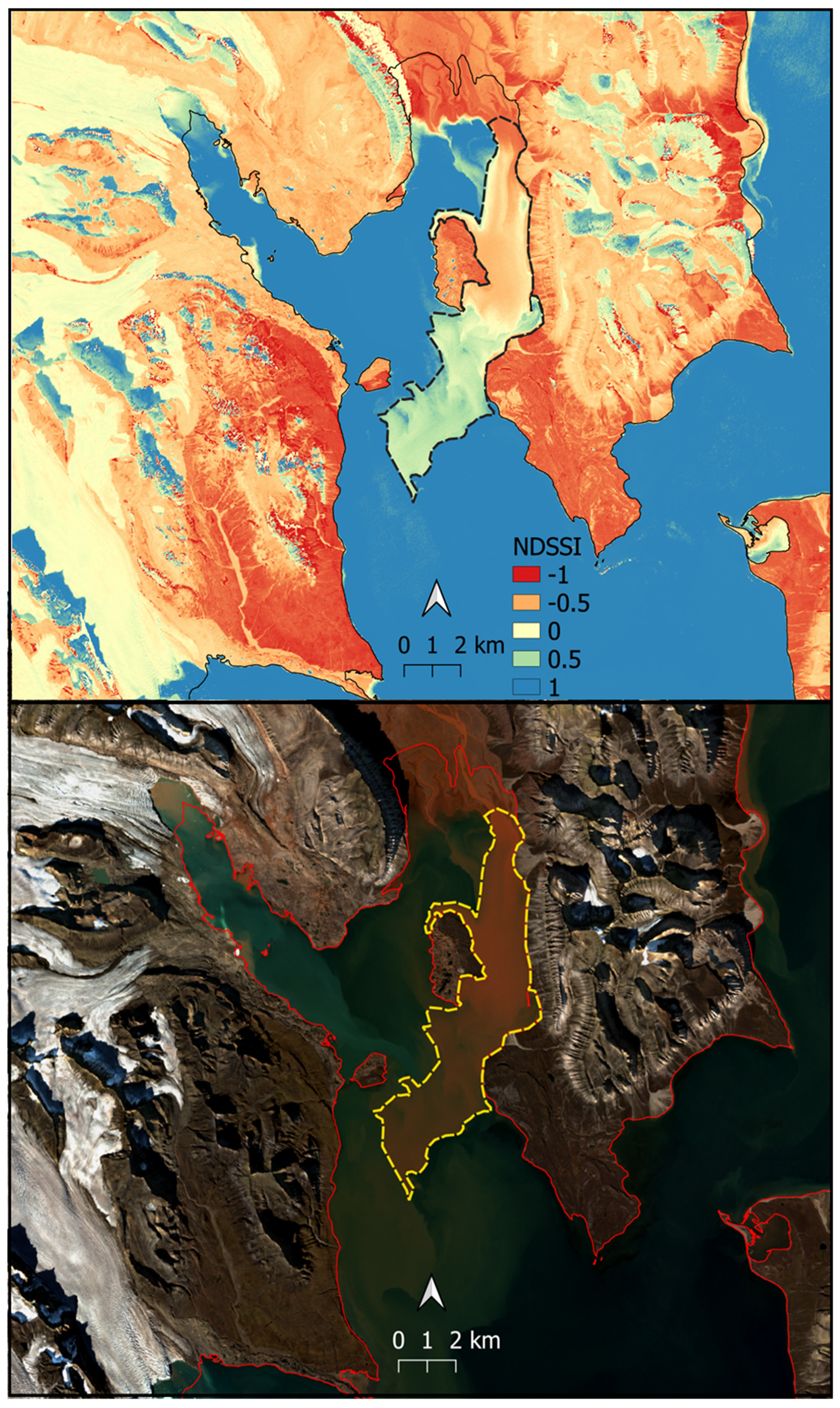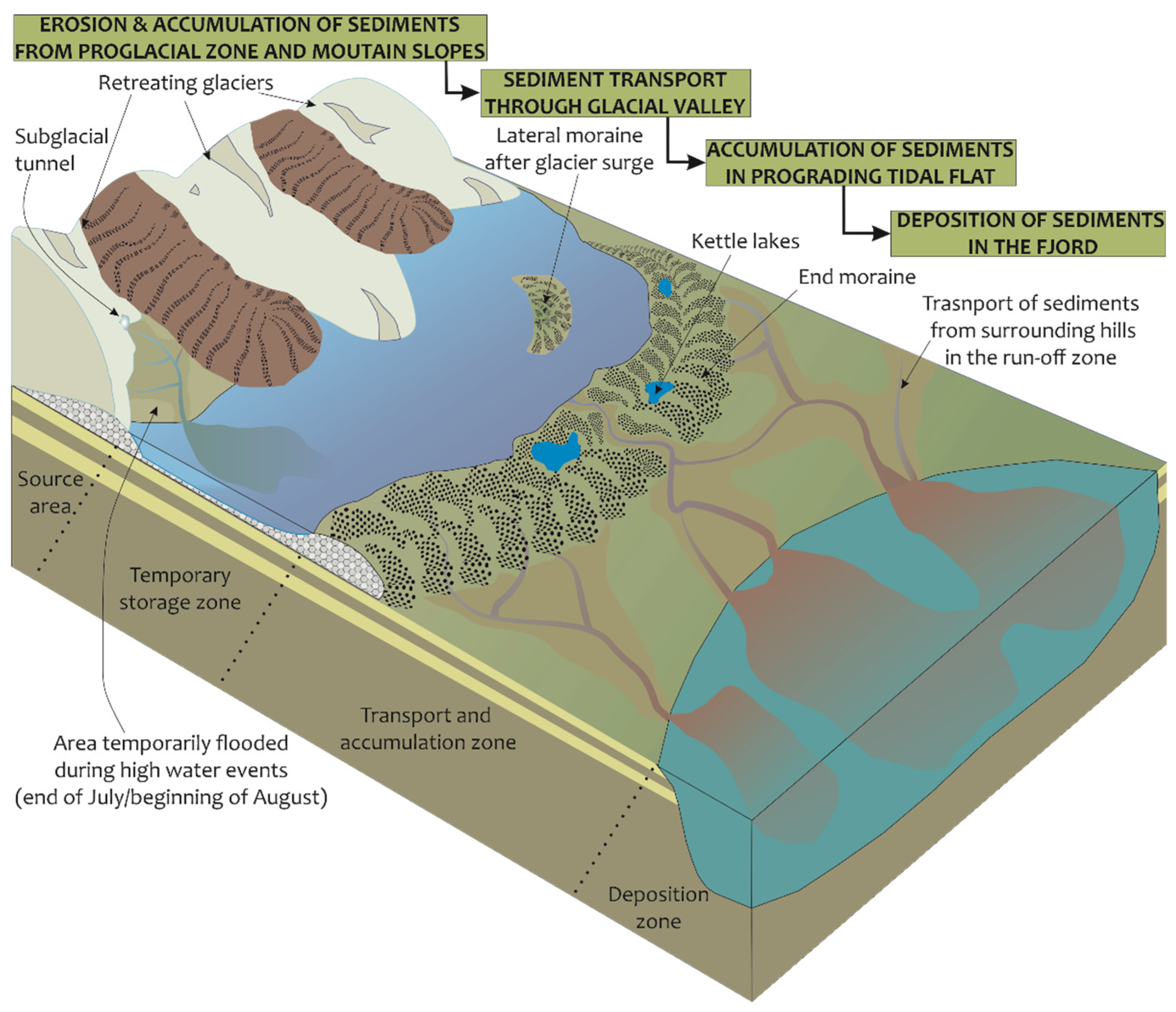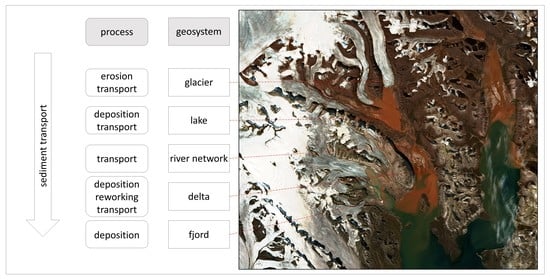Estimating Suspended Sediment Fluxes from the Largest Glacial Lake in Svalbard to Fjord System Using Sentinel-2 Data: Trebrevatnet Case Study
Abstract
:1. Introduction
1.1. Sediment Plumes
1.2. Production and Transport of Sediment
1.3. Using Remote Sensing to Detect Suspended Sediment in Fjords and Coastal Waters
1.4. Aims
1.5. Study Site
2. Materials and Methods
3. Results and Discussion
3.1. Suspended Sediment Transport
3.2. Lake Areal Extent
3.3. Conceptual Model of the Geosystem
4. Conclusions
Author Contributions
Funding
Institutional Review Board Statement
Informed Consent Statement
Data Availability Statement
Conflicts of Interest
References
- Darlington, E.F. Meltwater Delivery from the Tidewater Glacier Kronebreen to Kongsfjorden, Svalbard; Insights from in-situ and Remote-Sensing Analyses of Sediment Plumes. Doctoral Dissertation, Loughborough University, Loughborough, UK, 2015. [Google Scholar]
- Schild, K.M.; Hawley, R.L.; Chipman, J.W.; Benn, D.I. Quantifying suspended sediment concentration in subglacial sediment plumes discharging from two Svalbard tidewater glaciers using Landsat-8 and in situ measurements. Int. J. Remote Sens. 2017, 38, 6865–6881. [Google Scholar] [CrossRef]
- Porter, P.R.; Vatne, G.; Ng, F.; Irvine-Fynn, T.D. Ice-marginal sediment delivery to the surface of a high-Arctic glacier: Austre Brøggerbreen, Svalbard. Geogr. Ann. Ser. A Phys. Geogr. 2010, 92, 437–449. [Google Scholar] [CrossRef]
- Hewitt, I.J. Subglacial plumes. Annu. Rev. Fluid Mech. 2020, 52, 145–169. [Google Scholar] [CrossRef]
- Meslard, F.; Bourrin, F.; Many, G.; Kerhervé, P. Suspended particle dynamics and fluxes in an Arctic fjord (Kongsfjorden, Svalbard). Estuar. Coast. Shelf Sci. 2018, 204, 212–224. [Google Scholar] [CrossRef]
- Bogen, J.; Bønsnes, T.E. Erosion and sediment transport in High Arctic rivers, Svalbard. Polar Res. 2003, 22, 175–189. [Google Scholar] [CrossRef]
- How, P.; Schild, K.M.; Benn, D.I.; Noormets, R.; Kirchner, N.; Luckman, A.; Vallot, D.; Hulton, N.R.; Borstad, C. Calving controlled by melt-under-cutting: Detailed calving styles revealed through time-lapse observations. Ann. Glaciol. 2019, 60, 20–31. [Google Scholar] [CrossRef] [Green Version]
- Jørgensen, B.B.; Laufer, K.; Michaud, A.B.; Wehrmann, L.M. Biogeochemistry and microbiology of high Arctic marine sediment ecosystems—Case study of Svalbard fjords. Limnol. Oceanogr. 2021, 66, S273–S292. [Google Scholar] [CrossRef]
- Torsvik, T.; Albretsen, J.; Sundfjord, A.; Kohler, J.; Sandvik, A.D.; Skarðhamar, J.; Lindbäck, K.; Everett, A. Impact of tidewater glacier retreat on the fjord system: Modeling present and future circulation in Kongsfjorden, Svalbard. Estuar. Coast. Shelf Sci. 2019, 220, 152–165. [Google Scholar] [CrossRef]
- Kehrl, L.M.; Hawley, R.L.; Powell, R.D.; Brigham-Grette, J. Glacimarine sedimentation processes at Kronebreen and Kongsvegen, Svalbard. J. Glaciol. 2011, 57, 841–847. [Google Scholar] [CrossRef] [Green Version]
- Lydersen, C.; Assmy, P.; Falk-Petersen, S.; Kohler, J.; Kovacs, K.M.; Reigstad, M.; Steen, H.; Strøm, H.; Sundfjord, A.; Varpe, Ø.; et al. The importance of tidewater glaciers for marine mammals and seabirds in Svalbard, Norway. J. Mar. Syst. 2014, 129, 452–471. [Google Scholar] [CrossRef]
- Mugford, R.I.; Dowdeswell, J.A. Modeling glacial meltwater plume dynamics and sedimentation in high-latitude fjords. J. Geophys. Res. Earth Surf. 2011, 116, F01023. [Google Scholar] [CrossRef]
- Dowdeswell, J.A.; Hogan, K.A.; Arnold, N.S.; Mugford, R.I.; Wells, M.; Hirst, J.P.P.; Decalf, C. Sediment-rich meltwater plumes and ice-proximal fans at the margins of modern and ancient tidewater glaciers: Observations and modelling. Sedimentology 2015, 62, 1665–1692. [Google Scholar] [CrossRef] [Green Version]
- How, P.; Benn, D.I.; Hulton, N.R.J.; Hubbard, B.; Luckman, A.; Sevestre, H.; van Pelt, W.J.J.; Lindbäck, K.; Kohler, J.; Boot, W. Rapidly changing subglacial hydrological pathways at a tidewater glacier revealed through simultaneous observations of water pressure, supraglacial lakes, meltwater plumes and surface velocities. Cryosphere 2017, 11, 2691–2710. [Google Scholar] [CrossRef] [Green Version]
- Holmes, F.A.; Kirchner, N.; Kuttenkeuler, J.; Krützfeldt, J.; Noormets, R. Relating ocean temperatures to frontal ablation rates at Svalbard tidewater glaciers: Insights from glacier proximal datasets. Sci. Rep. 2019, 9, 9442. [Google Scholar] [CrossRef] [PubMed]
- Marshall, G.J.; Rees, W.G.; Dowdeswell, J.A. Limitations imposed by cloud cover on multitemporal visible band satellite data sets from polar regions. Ann. Glaciol. 1993, 17, 113–120. [Google Scholar] [CrossRef] [Green Version]
- Østby, T.I.; Schuler, T.V.; Westermann, S. Severe cloud contamination of MODIS Land Surface Temperatures over an Arctic ice cap, Svalbard. Remote Sens. Environ. 2014, 142, 95–102. [Google Scholar] [CrossRef]
- Kavan, J.; Haagmans, V. Brief communication: Hydrologic connectivity of a tidewater glacier characterized with Sentinel-2 satellite images–a case study of Nordenskiöldbreen, Svalbard. Cryosphere Discuss. 2022. preprint. [Google Scholar] [CrossRef]
- Tallentire, G.D.; Shiggins, C.J.; Rawlins, L.D.; Evans, J.; Hodgkins, R. Observing relationships between sediment-laden meltwater plumes, glacial melt and a retreating terminus. Int. J. Remote Sens. in prepint.
- Everett, A.; Kohler, J.; Sundfjord, A.; Kovacs, K.M.; Torsvik, T.; Pramanik, A.; Boehme, L.; Lydersen, C. Subglacial discharge plume behaviour revealed by CTD-instrumented ringed seals. Sci. Rep. 2018, 8, 13467. [Google Scholar] [CrossRef] [PubMed]
- Marshall, S.J. Regime Shifts in Glacier and Ice Sheet Response to Climate Change: Examples From the Northern Hemisphere. Regime Shifts in Glacier and Ice Sheet Response to Climate Change: Examples From the Northern Hemisphere. Front. Clim. 2021, 3, 702585. [Google Scholar] [CrossRef]
- Nordli, Ø.; Przybylak, R.; Ogilvie, A.E.J.; Isaksen, K. Long-term temperature trends and variability on Spitsbergen: The extended Svalbard Airport temperature series, 1898–2012. Polar Res. 2014, 33, 21349. [Google Scholar] [CrossRef] [Green Version]
- Isaksen, K.; Nordii, Ø.; Førland, E.J.; Łupikasza, E.; Eastwood, D.; Niedźwiedź, T. Recent warming on Spitsbergen—Influence of atmospheric circulation and sea ice cover. J. Geophys. Res. Atmos. 2016, 121, 3446–3464. [Google Scholar] [CrossRef]
- Geyman, E.; van Pelt, W.; Maloof, A.; Aas, H.; Kohler, J. Historical glacier change on Svalbard predicts doubling of mass loss by 2100. Nature 2022, 601, 374–379. [Google Scholar] [CrossRef]
- Wieczorek, I.; Strzelecki, M.C.; Stachnik, Ł.; Yde, J.C.; Małecki, J. Inventory and classification of the post Little Ice Age glacial lakes in Svalbard. Cryosphere Discuss. 2022. preprint. [Google Scholar] [CrossRef]
- Schomacker, A.; Kjaer, K.H. Quantification of dead-ice melting in ice-cored moraines at the high-Arctic glacier Holmstrombreen, Svalbard. BOREAS 2008, 37, 211–225. [Google Scholar] [CrossRef]
- Ewertowski, M. Recent transformations in the high-Arctic glacier landsystem, Ragnarbreen, Svalbard. Geogr. Ann. Ser. A Phys. Geogr. 2014, 96, 265–285. [Google Scholar] [CrossRef] [Green Version]
- Lønne, I. Nemec WHigh-arctic fan delta recording deglaciation and environment disequilibrium. Sedimentology 2004, 51, 553–589. [Google Scholar] [CrossRef]
- Fjeldskaar, W.; Bondevik, S.; Amantov, A. Glaciers on Svalbard survived the Holocene thermal optimum. Quat. Sci. Rev. 2018, 199, 18–29. [Google Scholar] [CrossRef]
- Huss, M.; Hock, R. Global-scale hydrological response to future glacier mass loss. Nat. Clim. Chang. 2018, 8, 135–140. [Google Scholar] [CrossRef] [Green Version]
- Kvam, M.H. Deposits and Processes on the Tide-Influenced Fjord-Head Delta in Dicksonfjorden, Svalbard. Master’s Thesis, Deptartment of Geosciences, UiT—The Arctic University of Norway, Tromsø, Norway, 2018. [Google Scholar]
- Bendixen, M.; Lønsmann Iversen, L.; Anker Bjørk, A.; Elberling, B.; Westergaard-Nielsen, A.; Overeem, I.; Barnhart, K.R.; Khan, S.A.; Box, J.E.; Abermann, J.; et al. Delta progradation in Greenland driven by increasing glacial mass loss. Nature 2017, 550, 101–104. [Google Scholar] [CrossRef]
- Zajączkowski, M. Sediment supply and fluxes in glacial and outwash fjords, Kongsfjorden and Adventfjorden, Svalbard. Pol. Polar Res. 2008, 29, 59–72. [Google Scholar]
- Zajączkowski, M.; Włodarska-Kowalczuk, M. Dynamic sedimentary environments of an Arctic glacier-fed river estuary (Adventfjorden, Svalbard). I. Flux, deposition, and sediment dynamics. Estuar. Coast. Shelf Sci. 2007, 74, 285–296. [Google Scholar] [CrossRef]
- Kim, D.; Jo, J.; Nam, S.; Choi, K. Morphodynamic evolution of paraglacial spit complexes on a tide-influenced Arctic fjord delta (Dicksonfjorden, Svalbard). Mar. Geol. 2022, 447, 106800. [Google Scholar] [CrossRef]
- Gholizadeh, M.H.; Melesse, A.M.; Reddi, L. A comprehensive review on water quality parameters estimation using remote sensing techniques. Sensors 2016, 16, 1298. [Google Scholar] [CrossRef] [PubMed] [Green Version]
- Chu, V.W.; Smith, L.C.; Rennermalm, A.K.; Forster, R.R.; Box, J.E. Hydrologic controls on coastal suspended sediment plumes around the Greenland Ice Sheet. Cryosphere 2012, 6, 1–19. [Google Scholar] [CrossRef] [Green Version]
- Hudson, B.; Overeem, I.; McGrath, D.; Syvistski, J.P.M.; Mikkelsen, A.; Hasholt, B. MODIS observed increase in duration and spatial extent of sediment plumes in Greenland fjords. Cryosphere 2014, 8, 1161–1176. [Google Scholar] [CrossRef] [Green Version]
- Dekker, A.; Zamurovic-Nenad, Z.; Hoogenboom, H.; Peter, S. Remote sensing, ecological water quality modelling and in situ measurements: A case study in shallow lakes. Hydrol. Sci. J. 1996, 41, 531–547. [Google Scholar] [CrossRef]
- Li, R.R.; Kaufman, Y.J.; Gao, B.C.; Davis, C.O. Remote sensing of suspended sediments and shallow coastal waters. Geoscience and Remote Sensing. IEEE Trans. 2003, 41, 559–566. [Google Scholar] [CrossRef]
- Kabir, S.M.I.; Ahmari, H. Evaluating the effect of sediment color on water radiance and suspended sediment concentration using digital imagery. J. Hydrol. 2020, 589, 125189. [Google Scholar] [CrossRef]
- Smith, B.; Pahlevan, N.; Schalles, J.; Ruberg, S.; Errera, R.; Ma, R.; Giardino, C.; Bresciani, M.; Barbosa, C.; Moore, T. Chlorophyll-a Algorithm for Landsat-8 Based on Mixture Density Networks. Front. Remote Sens. 2021, 1, 5. [Google Scholar] [CrossRef]
- Long, C.M.; Pavelsky, T.M. Remote sensing of suspended sediment concentration and hydrologic connectivity in a complex wetland environment. Remote Sens. Environ. 2013, 129, 197–209. [Google Scholar] [CrossRef] [Green Version]
- Rumora, L.; Miler, M.; Medak, D. Impact of Various Atmospheric Corrections on Sentinel-2 Land Cover Classification Accuracy Using Machine Learning Classifiers ISPRS. Int. J. Geo-Inf. 2020, 9, 277. [Google Scholar] [CrossRef] [Green Version]
- Trinh, L.; Tarasov, M.K. Evaluation of suspended matter concentrations in surface water of the Tri An water reservoir (Vietnam) using the remote sensing data. Vestn. Mosk. Univ. Seriya 5 Geogr. 2016, 2, 38–43. (In Russian) [Google Scholar]
- Peterson, K.T.; Sagan, V.; Sidike, P.; Cox, A.L.; Martinez, M. Suspended Sediment Concentration Estimation from Landsat Imagery along the Lower Missouri and Middle Mississippi Rivers Using an Extreme Learning Machine. Remote Sens. 2018, 10, 1503. [Google Scholar] [CrossRef] [Green Version]
- Hossain, A.K.M.; Yafei, J.; Xiaobo, C. Development of Remote Sensing Based Index for Estimating/Mapping Suspended Sediment Concentration in River and Lake Environments. In Proceedings of the 8th International Symposium on Ecohydraulics (ISE 2010) 0435, Zaragoza, Spain, 12–16 September 2010; pp. 578–585. [Google Scholar]
- Hjelle, A. The Geology of Svalbard; Norsk Polarinstitutt: Oslo, Norway, 1993; 163p. [Google Scholar]
- Szczucinski, W.; Zajczkowski, M.; Scholten, J. Sediment accumulation rates in subpolar fjords–Impact of post-Little Ice Age glaciers retreat, Billefjorden, Svalbard. Estuar. Coast. Shelf Sci. 2009, 85, 345–356. [Google Scholar] [CrossRef]
- Przybylak, R.; Arazny, A.; Nordli, O.; Finkelnburg, R.; Kejna, M.; Budzik, T.; Migala, K.; Sikora, S.; Puczko, D.; Rymer, K.; et al. Spatial distribution of air temperature on Svalbard during 1 year with campaign measurements. Int. J. Climatol. 2014, 34, 3702–3719. [Google Scholar] [CrossRef]
- Nordli, Ø.; Wyszyński, P.; Gjelten, H.M.; Isaksen, K.; BAupikasza, E.; Nieezwiedz, T.; Przybylak, R. Revisiting the extended Svalbard Airport monthly temperature series, and the compiled corresponding daily series 1898–2018. Polar Res. 2020, 39, 3614. [Google Scholar] [CrossRef]
- Ambrožová, K.; Láska, K. Air temperature variability in the vertical profile over the coastal area of Petuniabukta, central Spitsbergen. Pol. Polar Res. 2017, 38, 41–60. [Google Scholar] [CrossRef] [Green Version]
- Láska, K.; Witoszová, D.; Prosek, P. Weather patterns of the coastal zone of Petuniabukta, central Spitsbergen in the period 2008–2010. Pol. Polar Res. 2012, 33. [Google Scholar] [CrossRef]
- Farnsworth, W.R.; Ingólfsson, Ó.; Retelle, M.; Schomacker, A. Over 400 Previously Undocumented Svalbard Surge-Type Glaciers Identified. Geomorphology 2016, 264, 52–60. [Google Scholar] [CrossRef]
- Boulton, G.S.; van der Meer, J.J.M.; Beets, D.J.; Hart, J.K.; Ruegg, G.H.J. The Sedimentary and Structural Evolution of a Recent Push Moraine Complex: Holmströmbreen, Spitsbergen. Dev. Quat. Sci. 2004, 4, 149–180. [Google Scholar] [CrossRef]
- Munir, M.; Ramadhan, A.F.; Nastiti, A.; Putri, A.A.; Bawono, M.R.K.S.; Afifah, Z.N.; Wicaksono, P. Utilization of Sentinel-2A imagery For Mapping The dynamics of Total Suspended Sediment at The River Mouth of The Padang City. In Proceedings of the 2019 5th International Conference on Science and Technology (ICST), Yogyakarta, Indonesia, 30–31 July 2019. [Google Scholar] [CrossRef]
- Zhang, Z.; He, G.; Wang, X. A practical DOS model-based atmospheric correction algorithm. Int. J. Remote Sens. 2010, 31, 2837–2852. [Google Scholar] [CrossRef]
- Moskalik, M.; Cwiakała, J.; Szczucinski, W.; Dominiczak, A.; Głowacki, O.; Wojtysiak, K.; Zagórski, P. Spatiotemporal changes in the 315 concentration and composition of suspended particulate matter in front of Hansbreen a tidewater glacier in Svalbard. Oceanologia 2018, 60, 446–463. [Google Scholar] [CrossRef]
- Schild, K.; Hawley, R.; Morriss, B. Subglacial hydrology at Rink Isbræ, West Greenland inferred from sediment plume appearance. Ann. Glaciol. 2016, 57, 118–127. [Google Scholar] [CrossRef] [Green Version]
- McGrath, D.; Steffen, K.; Overeem, I.; Mernild, S.H.; Hasholt, B.; Van Den Broeke, M. Sediment plumes as a proxy for local ice-sheet runoff in Kangerlussuaq Fjord, West Greenland. J. Glaciol. 2010, 56, 813–821. [Google Scholar] [CrossRef] [Green Version]
- Van Pelt, W.J.J.; Pohjola, V.A.; Pettersson, R.; Ehwald, L.E.; Reijmer, C.H.; Boot, W.; Jakobs, C.L. Dynamic Response of a High Arctic Glacier to Melt and Runoff Variations. Geophys. Res. Lett. 2018, 45, 4917–4926. [Google Scholar] [CrossRef] [Green Version]
- Majchrowska, E.; Ignatiuk, D.; Jania, J.; Marszałek, H.; Wąsik, M. Seasonal and interannual variability in runoff from the Werenskioldbreen catchment. Spitsbergen Pol. Polar Res. 2015, 36, 197–224. [Google Scholar] [CrossRef] [Green Version]
- Watson, C.S.; Quincey, D.J.; Carrivick, J.L.; Smith, M.W. The dynamics of supraglacial ponds in the Everest region, central Himalaya. Glob. Planet. Change 2016, 142, 14–27. [Google Scholar] [CrossRef]
- Lampkin, D.J.; VanderBerg, J. A preliminary investigation of the influence of basal and surface topography on supraglacial lake distribution near Jakobshavn Isbrae, western Greenland. Hydrol. Processes 2011, 25, 3347–3355. [Google Scholar] [CrossRef]
- Worni, R.; Huggel, C.; Clague, J.J.; Schaub, Y.; Stoffel, M. Coupling glacial lake impact, dam breach, and flood processes: A modeling perspective. Geomorphology 2014, 224, 161–176. [Google Scholar] [CrossRef]
- Kavan, J.; Nedbalová, L.; Nývlt, D.; Čejka, T.; Lirio, J. Status and short-term environmental changes of lakes in the area of Devil’s Bay, Vega Island, Antarctic Peninsula. Antarct. Sci. 2021, 33, 150–164. [Google Scholar] [CrossRef]
- Schuler, T.V.; Kohler, J.; Elagina, N.; Hagen, J.O.; Hodson, A.J.; Jania, J.A.; Kääb, A.M.; Luks, B.; Małecki, J.; Moholdt, G.; et al. Reconciling Svalbard Glacier Mass Balance. Front. Earth Sci. 2020, 8, 156. [Google Scholar] [CrossRef]
- Benn, D.I.; Evans, D.J.A. Glaciers and Glaciation; Routledge: London, UK, 2010; 816p, ISBN 978 0 340 905791. [Google Scholar]
- Kavan, J. Early twentieth century evolution of Ferdinand glacier, Svalbard, based on historic photographs and structure-from-motion technique. Geogr. Ann. Ser. A Phys. Geogr. 2020, 102, 57–67. [Google Scholar] [CrossRef]






Publisher’s Note: MDPI stays neutral with regard to jurisdictional claims in published maps and institutional affiliations. |
© 2022 by the authors. Licensee MDPI, Basel, Switzerland. This article is an open access article distributed under the terms and conditions of the Creative Commons Attribution (CC BY) license (https://creativecommons.org/licenses/by/4.0/).
Share and Cite
Kavan, J.; Wieczorek, I.; Tallentire, G.D.; Demidionov, M.; Uher, J.; Strzelecki, M.C. Estimating Suspended Sediment Fluxes from the Largest Glacial Lake in Svalbard to Fjord System Using Sentinel-2 Data: Trebrevatnet Case Study. Water 2022, 14, 1840. https://doi.org/10.3390/w14121840
Kavan J, Wieczorek I, Tallentire GD, Demidionov M, Uher J, Strzelecki MC. Estimating Suspended Sediment Fluxes from the Largest Glacial Lake in Svalbard to Fjord System Using Sentinel-2 Data: Trebrevatnet Case Study. Water. 2022; 14(12):1840. https://doi.org/10.3390/w14121840
Chicago/Turabian StyleKavan, Jan, Iwo Wieczorek, Guy D. Tallentire, Mihail Demidionov, Jakub Uher, and Mateusz C. Strzelecki. 2022. "Estimating Suspended Sediment Fluxes from the Largest Glacial Lake in Svalbard to Fjord System Using Sentinel-2 Data: Trebrevatnet Case Study" Water 14, no. 12: 1840. https://doi.org/10.3390/w14121840
APA StyleKavan, J., Wieczorek, I., Tallentire, G. D., Demidionov, M., Uher, J., & Strzelecki, M. C. (2022). Estimating Suspended Sediment Fluxes from the Largest Glacial Lake in Svalbard to Fjord System Using Sentinel-2 Data: Trebrevatnet Case Study. Water, 14(12), 1840. https://doi.org/10.3390/w14121840






